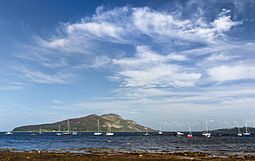Holy Island, Firth of Clyde facts for kids
The Holy Island (also called Holy Isle) is a small island in Scotland. It's located in the Firth of Clyde, which is a large bay on the west coast of central Scotland. You can find it inside Lamlash Bay, right next to the bigger Isle of Arran.
This island is about 3 kilometers (1.9 miles) long and 1 kilometer (0.6 miles) wide. Its highest point is a hill called Mullach Mòr. The island has a special history and is known for its peaceful atmosphere.
| Gaelic name | An t-Eilean Àrd or Eilean MoLaise |
|---|---|
| Meaning of name | "the high island" or "Laisren's island" in Gaelic. |
 Holy Island from Lamlash |
|
| OS grid reference | NS063297 |
| Coordinates | 55°32′N 5°04′W / 55.53°N 5.07°W |
| Physical geography | |
| Island group | Firth of Clyde |
| Area | 253 ha (1 sq mi) |
| Area rank | 95 |
| Highest elevation | Mullach Mòr, 1,030 ft (314 m) – a Marilyn |
| Administration | |
| Sovereign state | United Kingdom |
| Country | Scotland |
| Council area | North Ayrshire |
| Demographics | |
| Population | 31 |
| Population density | 12/km2 (31/sq mi) |
| Mullach Mòr | |
|---|---|
| Highest point | |
| Elevation | 1,030 ft (310 m) |
| Prominence | 1,030 ft (310 m) |
| Listing | Marilyn |
| Naming | |
| English translation | Big hill |
| Language of name | Gaelic |
| Geography | |
| Location | Firth of Clyde, Scotland |
| OS grid | NS063297 |
| Topo map | OS Landranger 69 |
Contents
A Look Back in Time
Holy Island has been seen as a special, sacred place for a very long time. There's a natural spring, or "holy well," that people believed had healing powers. You can also find a cave where a monk named St Molaise lived in the 6th century. He was a hermit, meaning he lived alone.
People have found signs of a monastery from the 1200s on the island. An old Scottish Gaelic name for the island was Eilean MoLaise, which means "Molaise's Island." This name is actually where the nearby village of Lamlash got its name!
Some ancient runic writing can be seen on the roof of St Molaise's cave. This shows that people from different cultures visited the island. Before the famous Battle of Largs, a Viking fleet even found shelter between Arran and Holy Island.
In 1549, a writer named Dean Monro mentioned the island. He wrote about a monastery that was built there but had since fallen into ruin.
Holy Island Today
In 1992, something interesting happened. The island was given to the Samyé Ling Buddhist Community. This community belongs to a type of Tibetan Buddhism called Kagyu.
The Centre for World Peace and Health
On the north side of the island, you'll find the Centre for World Peace and Health. This center was started by Lama Yeshe Losal Rinpoche. It's a special place where people can stay for courses and retreats. It's designed to be kind to the environment. For example, it uses solar power to heat water. It also has a special system to treat sewage using reed beds.
When you arrive by ferry, you'll see the path decorated with colorful Tibetan flags and stupas. Stupas are special dome-shaped buildings in Buddhism.
Nuns and Nature
On the southern part of the island, there's a community of nuns. These nuns live there and spend three years at a time in quiet retreats.
The rest of Holy Island is a nature reserve. This means it's a protected area for plants and animals. You might see wild Eriskay ponies roaming around. There are also Saanen goats and Soay sheep. People are also working to replant native trees on the island.
A very rare tree called the Rock Whitebeam grows here. This tree is important because it's linked to the evolution of the unique Arran Whitebeam species. These special trees, like Sorbus arranensis, Sorbus pseudofennica, and Sorbus pseudomeinichii, only grow on Arran and Holy Island.
There's a regular ferry that takes visitors from Lamlash to Holy Island. The island is a popular spot for people on holiday on Arran. In 2011, 31 people lived on the island, which was more than the 13 people recorded in 2001.
Gallery





